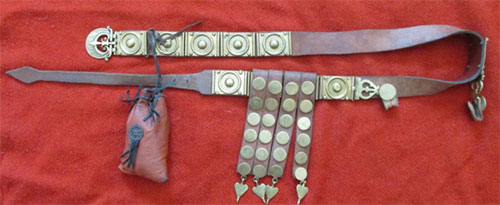 A balteus (plural baltei) is a very specific style of a belt. It was used by the Roman legionnaires to suspend a sword. But it wasn’t just a functional accessory – such belts showed the social status of a man and distinguished him from civilians. Baltei were a status thing and only military men were allowed to wear them. Such belts were also very beautiful items and looked like masterpieces. We’d like to make you acquainted with a unique Roman balteus belt and its peculiarities.
A balteus (plural baltei) is a very specific style of a belt. It was used by the Roman legionnaires to suspend a sword. But it wasn’t just a functional accessory – such belts showed the social status of a man and distinguished him from civilians. Baltei were a status thing and only military men were allowed to wear them. Such belts were also very beautiful items and looked like masterpieces. We’d like to make you acquainted with a unique Roman balteus belt and its peculiarities.
The Roman legionnaires had a high status among other citizens, and almost every item of their attire showed it – clothes, accessories, jewelry, weapons. More than that, each particular piece also determined the owner’s place in the military rank, sort of like modern shoulder marks do.
And a sword belt called “balteus” was one of those important accessories that could tell you a lot about the man wearing it. It was popular among the Roman legionnaires in the 2nd half of the 1st – early 2nd century A.D. Such belts were usually made from leather and very ornate, decorated with costly and skillfully made metal belt plates and belt buckles (most often, bronze with engraved or cast ornaments). And it’s logical since a balteus was worn on top of a tunic and armor, so it was visible to everybody around and easily caught attention.
A balteus belt had a lovely detail – leather straps called “baltea” (plural balteum) adorned with round decorative plates and pendants at the ends. They hang at the front to around mid-thigh (although, they shouldn’t be longer than the tunic underneath) and served as a stylized leather apron. Usually, there were 4-8 such leather straps. Historians believe that this apron had a decorative function and was inspired by the belt décor fashionable in the previous era.

Modern replica of Ancient Roman balteus created by Serhii Shamenkov
The belt plates on a balteus were usually hammered or cast. They could be embellished with engraved or cast floral and geometric designs. Of course, the richness and decorativeness of the belt depended on the financial capability of a man. These decorative belt plates, buckles, and other adornments were handmade by the traveling workshops and artisans. So, the soldiers bought embellishments for their baltei according to their budget, taste, and regional fashion. Only later, the state workshops appeared and started to provide such handicrafts for the legionnaires.
Around the 1st century A.D., the legionnaires wore two belts. One of them was used to attach a sword and the other for a dagger. By the way, the ordinary legionnaires wore their dagger on the left side and the centurions (Roman commanders) on the right side. This little detail could save your life when you met a soldier in the street and didn’t know how to greet him or communicate with him. At the end of the 1st – the beginning of the 2nd century, the Roman military men switched to using only one belt with a dagger, while the sword was attached to a baldric (a belt worn over one shoulder).


